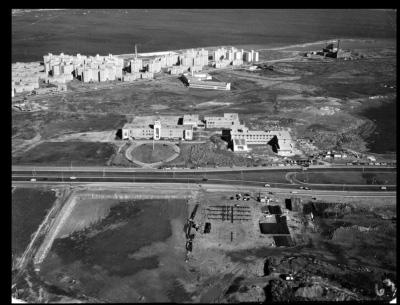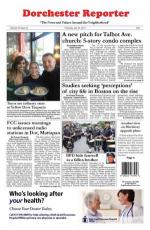June 16, 2017

Dorchester before the Globe: The present site of the Boston Globe (foreground) is visible in this aerial image from the mid-1950s.
In the wee hours of Mon., May 12, 1958, the roar of printing presses and the revving of truck engines announced the arrival of The Globe Newspaper Co. at its new home, 135 Morrissey Boulevard in Dorchester. For the previous 86 years, right up to the day before the move, the Globe had sent its editions, The Daily Globe in the morning, the Evening Globe in the afternoon, and The Sunday Globe, to its readers throughout New England from a venerable building on over-trafficked Newspaper Row on Washington Street in downtown Boston where the paper had been born in 1872.
This month, the company is moving out of Dorchester; its presses and trucks are already operating in faraway Taunton, and the business and editorial staffs are returning to State Street downtown, a few steps away from the Globe’s 19th-century birthplace. Times have changed once again, it’s an online world, and the newspaper’s future is fraught with challenge. But that’s a story for another time.
The newspaper’s Dorchester years have been eventful. As it settled into its new digs 59 years ago, the Globe was firmly in the middle of the pack in a city where seven daily newspapers were vying for readership – The two Globes, the morning Herald, the afternoon Traveler, two Hearst tabloids, the Record and the American, and the Christian Science Monitor. The paper kept up the pace at following the news while keeping its distance from using its pages to advocate its positions directly in municipal, state, and national affairs. That was about to change, and dramatically.
The Taylor family, whose patriarch, the Civil War veteran Charles H. Taylor, was hired by the year-old Globe in 1873 as its general manager and de facto publisher and editor-in-chief, gambled that an efficient new building with easy access to the highways being built around the city at the time would be the key to its long-term success. And so it was. Over the next decade or so, The Globe as an institution was born again as an aggressive new generation of journalists and talented sales, advertising, and production staffs drove the paper to regional preeminence in circulation, advertising, and influence, the last named coming from the liberal bent that the paper brought to its editorials and story assignments.
The revival was not universally seen as a good thing for regional Boston. With the growth in papers sold, advertising gained, and prizes won, some readers and advertisers sensed a touch of hubris, even malice, in how the Globe conducted business, covered the news, and delivered opinions.
The drama of the Globe’s rebirth was directed by Thomas Winship, who took over as editor-in-chief in 1965 after a few years of desk-editing experience. He had been custom-fitted for the job; his father, Laurence L. Winship, had managed the newsroom for the previous 44 years. It took a few years, but the younger Winship, an evangelist who preached forceful newspapering, began drawing to Boston a youthful cadre of reporters eager to tell the story of rapidly changing times, a period that began with the ascent to the presidency and subsequent assassination of a local boy made good, John F. Kennedy, and continued through the civil rights movement, the war in Vietnam, and, locally, the disassembling of a sorry educational system, and daily confrontations with an often-corrupt political assemblage.
For decades, the Globe’s editorials had featured the musings of a team of essayists who collectively wrote under the name Uncle Dudley and rarely involved themselves in street-level political disputation. Under his new order, Tom Winship wanted the Globe to speak up about what was happening, and the Taylors gave him the pulpit.
Winship’s coming-out party occurred during his first year as top editor when the paper’s aggressive reporting helped block the nomination of a barely credentialed Kennedy family associate to a federal judgeship, an accomplishment that earned the Globe the first of its 26 Pulitzer Prizes. Two years later, the newspaper endorsed a candidate for office for the first time in almost 70 years, touting Kevin H. White for mayor over Louise Day Hicks, a central and controversial figure in the long-running Boston school desegregation saga.
It was from its coverage of the federally mandated desegregation of the Boston schools that the Globe drew the most disdain, much of it from longtime readers of the paper. Some fired bullets at the building, some saw fit to damage circulation trucks, and others simply cringed over what the paper was doing with its coverage of the city’s neighborhoods . Forever after, Winship, who at the time directed both the newsroom and the editorial pages, maintained that the Globe had one overriding editorial goal when it came to the desegregation issue: Persuade people to follow the law.
By the time he retired in 1984, the editor, with the help of a cabinet of stalwart senior editors from the old regime, had the Globe’s news engine humming; he had set a new pace and his successors have kept the faith. There was the establishment in the late ‘60s of the paper’s Spotlight Team, whose members took months of reporting on cases that in almost every instance engendered reform or renewal – no-show politicians, corruption in Somerville, the FBI’s unseemly associations with the Mafia and a man named Whitey and his friends, and, in the new century, a world-shaking uncovering of the sinful ways of Catholic clerics as they dealt with child abusers in their ranks.
Other prize-winning investigations were led by departmental teams in metro, national, foreign, business, and sports, the latter a section with high national prestige, and individual Pulitzer winners were spread across the editorial landscape as the years went by. There were lapses, too, of ethics and taste, and from time to time the Globe simply didn’t deliver the goods individually and corporately.
There’s so much more that can be said about the newspaper’s stay on Morrissey Boulevard, but it’s time to close the notebook. For close to 60 years a cast of thousands of highly capable journalists and their associates in the business and circulation offices and the production and delivery units came to Dorchester and, like the Savin Hill and Mailbu beaches down the road, they made waves every day.
Tom Mulvoy worked at the Globe from 1966 to 2001, his last 15 years there as managing editor.
Making a newspaper with hot type
In a time when wonders are accomplished with the tap of a mouse-click, the closing of a large newspaper plant reminds a few what it was like to see an edition in pre-computer days.
The Globe in the late 1960s and early 1970s had three regular morning editions, with replates (updates) as needed, and as many as six runs of the Evening Globe in the late morning through the late afternoon, so there was little time available to gauge the way the news winds were blowing, given the competition: a burgeoning broadcast reality, the broadsheet Brahmin-managed Herald in the morning, the Traveler in the evening, and the tabloid Hearst publications seemingly all the time.
The lights never dimmed in the newsroom. The clatter of voices and typewriters filled the building 24/7 from front to back and from top to bottom; rattling syndicated service printers, with their bells arranged to ring when a big story broke, spewed reams of copy out of the wire room every minute of the day. Stories, written and edited on three- and four-ply paper so there would be plenty of duplicates, and headlines were glued together by editors and sent to the composing room via a gravity tube where specialized teams of printers (out of an overall compositor cast of 600) re-typed the copy through linotype machines, mechanical marvels that produced hundreds, even thousands of a separate lines of lead (called “hot type”) that were put into metal galleys and delivered to the proper stone table for insertion into the page forms.
There was a separate unit for the larger headlines, know as the Ludlow press. There was no kerning (reducing type size horizontally as computers do today at an editor’s direction); headlines had to fit the forms the compositors used for the various point sizes, which for The Globe at that time ranged from 18-point for the smallest headline to 96 and more for wartime, moonwalk, blizzard, and hurricane editions.
Another set of printers matched the story proofs with the original newsroom wording, fixed what were called “typos,” and moved the galleys along to the makeup stones where printers set the copy into individual page-sized metal forms, or chases, where, at the editors’ design, they were laid out with mounted half-tone photo images from the photo-engraving department to make up the final pages.
As this was going on, photographers were taking their work into the backroom of their department where they and their associates developed them into and out of the “soup,” and then brought their selections of the finished work to the copy desks in news, business, sports, and Living/Arts. The photos that made the layouts were then taken downstairs to the engraving department by editorial assistants, and thence to the composing room for final makeup.
From there, compositors delivered the forms to their crafts brothers in the stereotype section who converted the flat pages into curved forms that fit onto the presses where, after all were accounted for, the horn sounded for the start of the edition.
This intricate process was time-consuming, and it mandated strict deadlines for the delivery of the bulk of the copy from the newsroom to the production teams. While some allowance was built into the process for a Page One late-breaking story, the deadline for the first morning edition in 1970 was 9:30 p.m. for an 11:15 press start.
The building was throbbing with vitality at deadline, a time marked in the newsroom by noisy exchanges involving writers, photographers, and editors, many of who smoked, some without stop. Downstairs, where it all came together, editors and printers and photoengravers and stereotypers worked under a thin cloud of hot-type dust and cigarette and cigar smoke. It was a theater scene now lost to the ages.
A staff writer’s story was processed through several generations of editing and production – reporter’s desk to city desk to copy desk to slot editor to composing room typesetter to composing room proofreader to composing room correct-man to final proof to page form where editors and printers could make one last check by reading the type upside down. And it all happened as the newsroom underwent its continual renovations en route to the computer age.
– TOM MULVOY
Villages:
Topics:
Tags:



